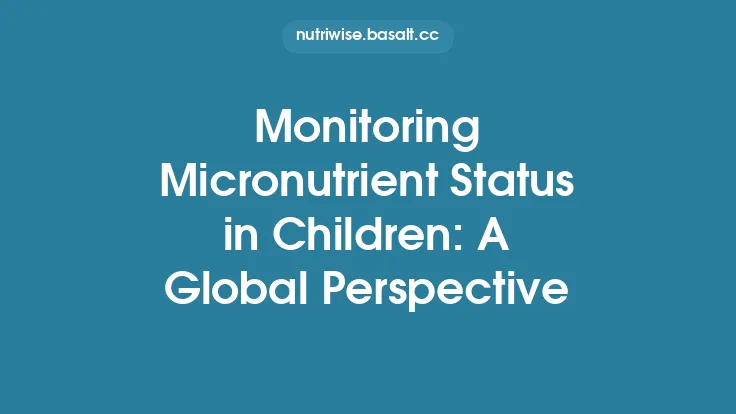Micronutrient deficiencies—often termed “hidden hunger”—affect more than two billion people worldwide, undermining physical growth, cognitive development, immune competence, and productivity. While the absolute burden of deficiency is substantial, its distribution is far from uniform. Geographic variation emerges from a complex interplay of environmental, socioeconomic, cultural, and health‑system factors that shape dietary intake, absorption, and utilization of essential vitamins and minerals. Understanding these patterns through an epidemiologic lens is critical for designing targeted interventions, allocating resources efficiently, and monitoring progress toward global nutrition goals.
Epidemiologic Foundations for Studying Micronutrient Deficiencies
Epidemiology provides the conceptual and methodological toolkit needed to quantify the magnitude of micronutrient gaps, identify at‑risk populations, and explore causal pathways. Core concepts include:
- Prevalence and Incidence – Prevalence captures the proportion of individuals with a deficiency at a given time, while incidence (less commonly used for chronic deficiencies) reflects new cases arising over a period. Cross‑sectional surveys are the primary source of prevalence data for micronutrients.
- Risk Factor Analysis – Multivariable regression models (logistic, Poisson, or negative binomial) allow researchers to isolate independent predictors of deficiency, adjusting for confounders such as age, sex, socioeconomic status, and infection burden.
- Ecological and Spatial Analyses – Geographic Information Systems (GIS) and spatial statistics (e.g., Moran’s I, Getis‑Ord Gi*) detect clustering of deficiencies and relate them to environmental covariates (soil mineral content, climate, altitude).
- Life‑Course Perspective – Longitudinal cohort studies illuminate how early‑life deficiencies influence later health outcomes, providing evidence for intergenerational transmission of risk.
Standardized case definitions are essential for comparability. The World Health Organization (WHO) and the Micronutrient Initiative have established biomarker thresholds (e.g., serum ferritin <15 µg/L for iron deficiency, urinary iodine concentration <100 µg/L for iodine deficiency) that serve as reference points across studies.
Global Landscape of Key Micronutrient Deficiencies
Although the specific micronutrients of concern vary by region, four deficiencies dominate the global epidemiologic picture:
| Micronutrient | Global Prevalence (est.) | Primary Clinical Consequences |
|---|---|---|
| Iron | ~30 % of women of reproductive age; ~25 % of preschool children | Anemia, impaired cognition, reduced work capacity |
| Iodine | ~15 % of school‑age children (based on urinary iodine) | Goiter, cretinism, reduced IQ |
| Zinc | ~20 % of children under five | Stunted growth, increased infection risk |
| Vitamin A | ~15 % of preschool children (based on serum retinol) | Night blindness, heightened mortality from infections |
These figures mask substantial heterogeneity. For instance, iron deficiency anemia (IDA) prevalence exceeds 50 % among adolescent girls in South Asia, yet falls below 10 % in many high‑income European nations. Iodine sufficiency, once achieved in many coastal regions through natural sea‑food consumption, remains elusive in inland high‑altitude zones where soil iodine is depleted.
Regional Patterns and Determinants
1. Sub‑Saharan Africa
- Zinc and Iron – Low soil zinc concentrations, high prevalence of helminth infections, and diets heavily reliant on phytate‑rich cereals limit bioavailability.
- Vitamin A – Seasonal fluctuations in fruit and vegetable availability, coupled with limited fortification infrastructure, drive periodic spikes in deficiency.
2. South Asia
- Iron – High rates of menstrual blood loss, low consumption of animal‑source foods, and widespread anemia‑promoting infections (malaria, hookworm) create a “perfect storm.”
- Iodine – Historically endemic goiter in the Himalayan foothills; recent universal salt iodization (USI) programs have reduced prevalence, yet pockets of inadequacy persist in remote districts lacking market access.
3. Latin America and the Caribbean
- Vitamin A – Rural Andean and Amazonian communities experience higher deficiency due to limited access to fortified foods and reliance on monotonous staple diets.
- Iodine – Coastal populations often achieve sufficiency through seafood, whereas inland highland areas remain vulnerable.
4. Middle East and North Africa (MENA)
- Iron – Conflict‑driven displacement disrupts food supply chains, leading to acute spikes in anemia among refugee populations.
- Zinc – High consumption of refined wheat products, low intake of legumes and nuts, and limited fortification contribute to suboptimal status.
5. High‑Income Nations
- Iron – Despite overall adequacy, specific subgroups (e.g., vegan women, low‑income adolescents) exhibit higher deficiency rates, underscoring the role of dietary patterns and socioeconomic gradients.
- Iodine – In some European countries, reduced use of iodized salt in processed foods has led to a resurgence of mild iodine insufficiency, especially among pregnant women.
Methodological Approaches to Mapping Deficiencies
Biomarker Selection and Standardization
Accurate assessment hinges on selecting biomarkers that reflect true nutritional status while accounting for inflammation and infection. For iron, serum ferritin is adjusted using C‑reactive protein (CRP) or α‑1‑acid glycoprotein (AGP) concentrations to mitigate the acute‑phase response. For zinc, plasma zinc is measured under fasting conditions, with attention to diurnal variation.
Survey Design and Sampling
Nationally representative nutrition surveys (e.g., Demographic and Health Surveys, Multiple Indicator Cluster Surveys) incorporate micronutrient modules. Two‑stage cluster sampling ensures geographic coverage, while oversampling of vulnerable groups (pregnant women, children under five) enhances statistical power for subgroup analyses.
Spatial Modeling Techniques
- Kriging – Interpolates point measurements to generate continuous surface maps of deficiency prevalence, useful for visualizing gradients across terrain.
- Bayesian Hierarchical Models – Integrate multiple data sources (survey, sentinel site, health facility) and incorporate prior information on covariates (soil mineral maps, climate data) to produce probabilistic estimates with quantified uncertainty.
Integration of Environmental Data
Geochemical databases (e.g., the Global Soil Nutrient Database) provide layer information on soil iron, zinc, and iodine content. Coupling these layers with dietary intake data elucidates the extent to which environmental scarcity translates into human deficiency.
Data Sources and Surveillance Systems
- National Nutrition Surveillance – Many countries maintain routine monitoring through health ministries, collecting hemoglobin, urinary iodine, and serum retinol data at health centers.
- Fortification Monitoring – Programs that mandate fortification of wheat flour (iron, zinc) or salt (iodine) generate compliance data that can be linked to population status.
- Laboratory Networks – Regional reference labs (e.g., the African Micronutrient Laboratory Network) standardize assay protocols, ensuring comparability across borders.
- Research Cohorts – Longitudinal birth‑cohort studies (e.g., the Birth to Twenty cohort in South Africa) provide high‑resolution data on micronutrient trajectories and health outcomes.
Case Studies
Iron Deficiency in South Asia
A pooled analysis of 12 national surveys revealed that adolescent girls in Bangladesh, Nepal, and India experience IDA prevalence ranging from 45 % to 62 %. Multivariate models identified three dominant predictors: low dietary heme iron intake (<10 g/day), high household poverty index, and residence in flood‑prone river basins where agricultural productivity is seasonally compromised. Intervention trials combining weekly iron‑folic acid supplementation with deworming reduced anemia prevalence by 18 % over 12 months, highlighting the synergistic effect of addressing both intake and infection.
Iodine Deficiency in the Andean Highlands
In Peru’s high‑altitude districts (>2,500 m), urinary iodine concentrations averaged 68 µg/L, well below the WHO adequacy threshold. Soil analyses indicated iodine concentrations <0.1 mg/kg, reflecting natural depletion. A community‑level USI program, coupled with distribution of iodized oil capsules to pregnant women, raised median urinary iodine to 115 µg/L within two years, and neonatal thyroid‑stimulating hormone (TSH) levels fell into the normal range, demonstrating rapid physiological response to fortification.
Zinc Deficiency in Sub‑Saharan Africa
A geostatistical map of plasma zinc in children under five across 15 African nations identified a pronounced “zinc desert” spanning northern Nigeria, Niger, and Chad. The model linked low zinc status to high dietary phytate intake (median 1,200 mg/day) and limited consumption of animal‑source foods (<30 g/day). A randomized controlled trial of zinc‑fortified wheat flour in Niger showed a 22 % reduction in diarrheal incidence and a modest increase in linear growth (0.4 cm gain over 6 months), supporting food‑based approaches in regions where supplementation logistics are challenging.
Vitamin A Deficiency in Central America
In rural Guatemala, serum retinol concentrations below 0.7 µmol/L affected 19 % of children aged 6–59 months. The deficiency correlated with low household production of orange‑fleshed sweet potatoes and limited access to fortified cooking oil. A bio‑fortification program introducing high‑β‑carotene sweet potato varieties achieved a 30 % increase in serum retinol after one harvest cycle, illustrating the potential of agricultural interventions to shift micronutrient status at the community level.
Implications for Public Health Policy and Intervention Design
- Targeted Fortification – Geographic mapping enables policymakers to prioritize fortification of locally consumed staples (e.g., maize flour in sub‑Saharan Africa, rice in South Asia) where deficiencies are most acute.
- Supplementation Tailored to Seasonality – In regions with marked seasonal food insecurity, timed distribution of micronutrient powders or lipid‑based nutrient supplements can bridge gaps during lean periods.
- Integration with Infectious Disease Control – Coordinating deworming, malaria prophylaxis, and micronutrient interventions maximizes health gains, especially for iron and zinc where infection drives loss.
- Strengthening Surveillance – Investing in laboratory capacity, standardizing biomarker protocols, and establishing real‑time data dashboards improve the ability to detect emerging deficiency hotspots.
- Community Engagement and Behavior Change – Nutrition education that respects cultural food practices and promotes consumption of locally available micronutrient‑rich foods (e.g., leafy greens, legumes, fish) sustains long‑term improvements.
Future Directions and Research Gaps
- Fine‑Scale Spatial Resolution – While national surveys provide broad estimates, sub‑national heterogeneity remains under‑characterized. Leveraging satellite‑derived vegetation indices and high‑resolution climate data could refine exposure models.
- Interaction with the Microbiome – Emerging evidence suggests gut microbial composition influences micronutrient absorption (e.g., vitamin B12 synthesis, iron uptake). Integrating microbiome profiling into epidemiologic studies may uncover novel determinants.
- Life‑Course Modeling – Longitudinal data linking early‑life micronutrient status to adult non‑communicable disease risk are sparse, particularly for zinc and iodine. Cohort expansion and harmonized biomarker collection are needed.
- Cost‑Effectiveness Analyses – Comparative assessments of fortification versus supplementation, accounting for geographic variation in baseline deficiency, will guide resource allocation in low‑ and middle‑income settings.
- Policy Implementation Research – Understanding barriers to effective fortification (e.g., supply‑chain constraints, regulatory enforcement) through mixed‑methods studies can accelerate translation of epidemiologic findings into practice.
By systematically charting where micronutrient gaps exist, elucidating the underlying drivers, and applying rigorous epidemiologic methods, researchers and policymakers can move beyond generic nutrition recommendations toward precision‑public‑health strategies. Such geographically attuned approaches are essential for closing the hidden‑hunger gap and achieving equitable nutrition outcomes worldwide.





